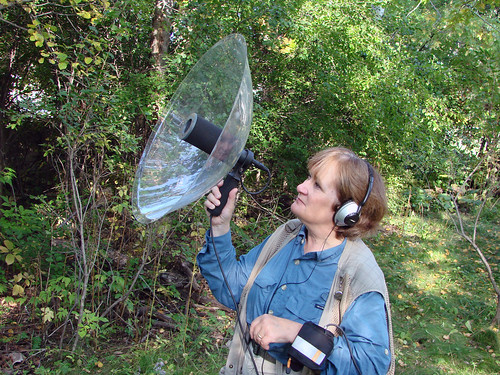Last week I ran as a radio rerun a "For the Birds" program that originally aired in 2000, about the silence of winter. The year after I did that program, I got some high-quality sound recording equipment and started appreciating how tragically rare silence is.
I hardly needed absolute silence to capture a pure rendition of the song of a warbler or thrush. I could limit my bird recording to calm, rainless days, and I learned a few microphone positioning tricks to minimize the effects of some natural noises.
But I had no chance of getting a clean recording in my own backyard no matter how perfect the meteorological conditions. I live in a very quiet neighborhood in Duluth, at least by the standards I’ve always used to define a quiet neighborhood. With my recording equipment, I discovered how many people had switched to high-efficiency gas furnaces—a great thing in every way except their noise level. And in summer, there are few half-hour blocks or time from early morning till evening when no one within hearing range is mowing a lawn. I’m 5 blocks in two directions from heavily used roads where truck traffic is common, and even on Peabody Street, cars come by way more often than I realized before I started recording birds.
I’m not the only one who notices small city noises. On January 17, the New York Times ran a story about how Stradivarius violins are, little by little, reaching the end point in their ability to produce their uniquely exquisite sounds. They wrote:
So that future generations won’t miss out on hearing the instruments, three sound engineers are producing the “Stradivarius Sound Bank” — a database storing all the possible tones that four instruments selected from the Museo del Violino’s collection can produce…The Museo del Violino is in Cremona, a city a bit smaller than Duluth, with a population of 72,000. The Stradivarius sounds are being played and recorded in an auditorium associated with the museum. But the project hit a roadblock. According to the article:
“This will allow my grandchildren to hear what a Strad sounded like,” said Leonardo Tedeschi, a former D.J. who came up with the idea for the project. “We are making immortal the finest instrument ever crafted.”
In 2017, the engineers thought their project was finally ready to get underway. But a soundcheck revealed a major flaw.Fortunately, the mayor of Cremona happens to be president of the Stradivarius Foundation. He ordered the streets around the museum to be closed for five weeks and appealed to people in the area to keep it down.
“The streets around the auditorium are all made of cobblestone, an auditory nightmare,” Mr. Tedeschi said. The sound of a car engine, or a woman walking in high heels, produces vibrations that run underground and reverberate in the microphones, making the recording worthless, he explained. “It was either shutting down the entire area or having the project not seeing the light of day.”
“We are the only city in the world that preserves both the instruments and their voices,” Mr. Galimberti said. “This is an extraordinary project that looks at the future, and I’m sure people from Cremona will understand that closing the area was inevitable.”Stopping all human noisemaking in one small area of one small city for five weeks turned out to be hard but doable, in a place where everyone understands how important it is to preserve Stradivarius tones. It’s impossible to stop traffic along a stretch of highway, much less get people to agree to suspend all activity in an area, just so someone can record natural sounds that we can hear every day during the right season. Silence really is golden, and even harder to come by.
